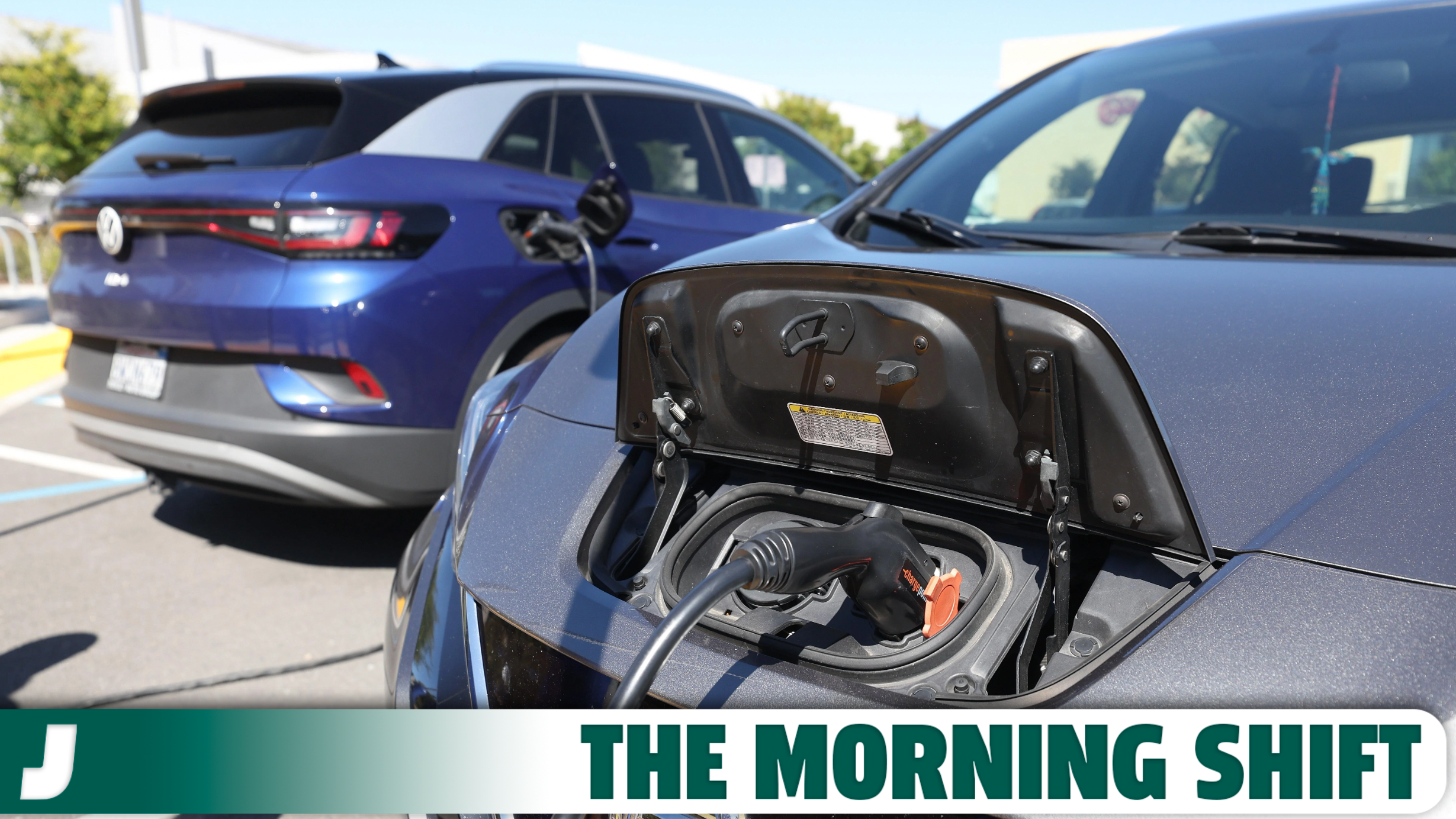EVs Are Losing Half Their Value In Just Three Years
Also, Tesla's China-made EV sales are falling fast, and Alaska Airlines is buying Hawaiian Airlines.
Good morning! It's Monday, December 4, 2023, and this is The Morning Shift, your daily roundup of the top automotive headlines from around the world, in one place. Here are the important stories you need to know.
1st Gear: Depreciation Is Hurting Used EVs
Electric vehicles are starting to make a real splash on the used-car market, but EVs are having a much harder time holding their value than internal-combustion-powered vehicles. EVs have more than doubled their presence on the wholesale market in the past couple of years, however, it's still a small sliver at just 1.7 percent of the market (14,538 sales). From Automotive News:
Price cuts on new battery-electric vehicles in 2023 have cut into the sticker prices used 2- to 4-year-old EVs are able to keep, Black Book chief data scientist Alex Yurchenko said. The weakness in value retention among EVs compared with other vehicles has grown in the past several months, and this is likely to continue with the "price wars" on new EV models, he said.
[...]
"As soon as the new-vehicle transaction prices come down, we're seeing the used prices come down," [Kristen Lanzavecchia, J.D. Power director of industry solutions] said.
Black Book predicts used-EV prices will continue to fall as new-EV prices drop, Yurchenko said. The weakness in value retention among EVs compared with other vehicles has grown in the past several months, and this is likely to continue with the "price wars" on new EV models, he said.
Black Book predicts the average 3-year-old vehicle in October 2023 held 66 percent of its original value, down from 73 percent last year but up from 51 percent in October 2019. The company predicts this stat will decline to 56 percent by October 2026.
The average 3-year-old EV, on the other hand, only held onto 49 percent of its original value in October of this year. That's down 70 percent from just a year ago, but it is up 33 percent from October 2019, probably because those early EVs were sort of terrible. Black Book expects 3-year-old electric vehicles to keep 45 percent of their value in October 2026. However, it admitted that comparing the future EV market to previous years was "probably useless" because a more diverse mix of EVs is coming.
Gregory said the price volatility in EVs might drive consumers to EV leasing. Faced with the prospect of buying a Ford F-150 Lightning only to see the automaker then cut the price by thousands of dollars, leasing looks attractive — particularly when the lease is subvented by the electric vehicle tax credit.
The Inflation Reduction Act contains an up to $7,500 tax credit for new-EV retail buyers, but it also offers a credit of up to $7,500 for commercial buyers such as lessors, who can choose whether to pass on the savings to customers.
Some automakers have been proponents of leasing because the commercial credit has fewer restrictions on which EVs qualify than the new-vehicle retail credit.
2nd Gear: China-made Teslas Sales Are Skidding
Sales of China-made Teslas slid 17.8 percent in November from the same period a year ago. The Austin, Texas-based automaker moved 82,432 vehicles it made in China. It marks the biggest fall since December 2022 when Tesla's sales of Chinese-made vehicles fell 21 percent on the year. It came at a time when it decided to reduce output and cut prices to deal with rising inventories and weakening demand.
Despite all this, deliveries of China-made Model 3s and Model Ys were actually 14.3 percent higher than in October. From Reuters:
Chinese rival BYD, with its Dynasty and Ocean series of EVs and petrol-electric hybrid models, saw passenger vehicle deliveries set another record at 301,378 vehicles in November, up 0.09% from October and 31% from a year earlier.
Tesla has been under pressure to fend off competition in the world's largest auto market, though CEO Elon Musk's charm offensive in China continues unabated.
Musk was among a small group of top U.S. executives who met with Chinese President Xi Jinping before a dinner event on the sidelines of the APEC summit in San Francisco in mid-November.
Xi expressed his support for Tesla's development in China, the automaker said in a Weibo post. Musk, in response, said he appreciated the rapid development of China's new energy vehicle sector.
At the start of 2023, Tesla triggered a price war in China among over 40 EV automakers in the country, but its EV market share still dropped to 5.78 percent in October from 8.7 percent in September.
Since late October of this year, Tesla has done five price increases in China where EV demand growth is slowing. It would seem more and more folks are buying plug-in hybrids right now.
3rd Gear: UnContinental Airlines
Alaska Airlines is buying Hawaiian Airlines for $18 per share, which works out to about $1.9 billion. The boards of both airlines have agreed on the deal, which is expected to close within the next year and a half. However, it still needs approval from U.S. regulators and Hawaiian Holding's (Hawaiian Airlines parent company) shareholders. From CBS News:
Regulatory approval is not a guarantee. The Justice Department is currently trying to block JetBlue's proposed acquisition of Spirit Airlines. Earlier this year, a federal judge ruled JetBlue and American Airlines needed to end their partnership, saying the alliance weakened competition and hurt consumers. Competition between airlines is the biggest cause of cheap flights, according to Scott Keyes, the founder of Going, a subscription service focused on finding airfare deals.
"A merger between these two airlines — whose route maps have dozens of flights that overlap — would result not in more cheap flights for consumers, but fewer," Keyes said about the Alaska-Hawaiin deal.
Under the terms of the new deal between Alaska Airlines and Hawaiian Airlines, the combined organization will be based in Seattle under the leadership of Alaska Airlines CEO Ben Minicucci. On an investor call about the merger, Minicucci said that out of about 1,400 plus daily flights, they'll overlap in just 12 markets. The CEO said that he believes "that lands very well" for regulatory approval.
[...]
The airlines said the move will preserve both brands and unlock more travel destinations for flyers. The combined company will offer service to 138 destinations, including non-stop service to 29 top international destinations in the Americas, Asia, Australia and the South Pacific, the statement said.
The Hawaiian Airlines airplane fleet is much different than Alaska's. It has Airbus A321s, A330s, Boeing 717s and an order for 12 Boening 787 Dreamliners. Alaska, on the other hand, is an all 737 fleet.
Hawaiian Airlines CEO Peter Ingram said Alaska Airlines approached Hawaiian about the merger.
"With the additional scale and resources that this transaction with Alaska Airlines brings, we will be able to accelerate investments in our guest experience and technology, while maintaining the Hawaiian Airlines brand," Ingram said in a statement.
Back in 2016, Alaska reached a deal to buy Virgin America, and the airline dropped the newly acquired company's name and logo.
4th Gear: Continental Parts Maker Has A Rough Time
Parts supplier Continental is evaluating asset sales and is planning to cut additional costs to protect returns and hopefully turn around its key automotive unit that has fallen a bit behind its competition. From Bloomberg:
The German parts maker on Monday announced plans to carve out the user experience business — which makes displays for car interiors — to ready it for a potential sale, joint venture or initial public offering. Continental will also reduce research and development spending, it said during an investor event in Hanover.
The moves will help the auto unit "become better, faster and more agile," Chief Financial Officer Katja Garcia Vila said in an interview.
Continental, whose market value has shrunk some 40% in the past five years, is among German industry stalwarts facing a wrenching transition to a cleaner economy. The changes are particularly painful for the automotive sector, which thrived because it perfected making combustion-engine cars, with hundreds of local parts makers supplying gearboxes, fuel injectors and crankshafts. Now that the battery is taking over, their "Vorsprung durch Technik" is evaporating.
At Monday's meeting, Continental confirmed its financial forecast for this year and increased its dividend payout plan to as much as 40% of net income, from as much as 30% previously. It updated its mid-term goals and now targets as much as €56 billion ($61 billion) in sales in three to five years, from €39.4 billion last year. The automotive unit is supposed to provide as much as half of that.
On top of the new user experience business, Continental says it is reviewing other automotive assets that generate about $1.5 billion in sales, which comes out to about a quarter of the entire auto division, is under review.
Continental previously announced thousands of job cuts to reduce expenses by around €400 million annually starting in 2025. Additional measures announced Monday include shrinking the number of the auto unit's 82 research sites to help cut the businesses' R&D expenses to 11% of sales in two to three years and less than 10% in three to five years, from an expected 12% this year.
The manufacturer has been facing higher costs for materials, labor, energy and logistics in its home market Germany, and in July announced plans to exit one of its factories there. It's also working through investigations about its role in the 2015 diesel-emissions cheating scandal, the fallout from a cyberattack and quality control failures in its industrial-hoses unit.
There's apparently some reason for optimism. In the past quarter, Continental reported positive free-clash flow and raised the outlook for operating profitability in its tire division.

